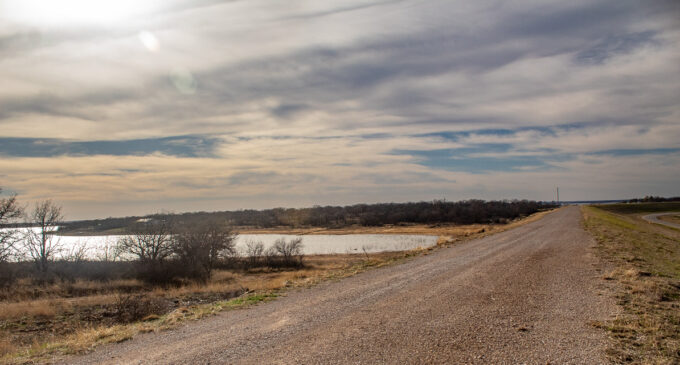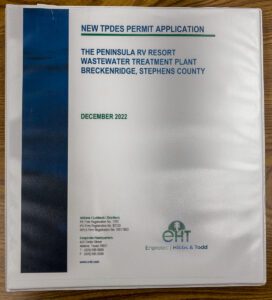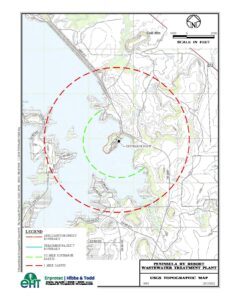Local residents express concerns about proposed wastewater treatment plant for planned RV resort at Hubbard Creek Lake

By Carla McKeown and Tony Pilkington/Breckenridge Texan
A change in the way a proposed RV resort plans to handle wastewater has some Hubbard Creek Lake residents concerned, but the property owner says that type of system is common throughout Texas and that the effluent will be cleaner than the water currently in the lake.
The owner of the Peninsula RV Resort has submitted an application to the Texas Commission on Environmental Quality requesting permission to build a wastewater treatment plant for the planned RV resort on a peninsula on the northeast side of the lake that will pipe the effluent directly into the lake. The plant would discharge up to 15,000 gallons of treated wastewater into the lake each day.
In response to the proposed plan, a group of local residents has sent a petition to the TCEQ, as well as posted comments on the TCEQ’s website. Both sides of the situation have issued statements to the Breckenridge Texan.
As detailed below, the complaints mostly focus on potential damage to the lake, which provides water for the City of Breckenridge residents, as well as a place for recreational water sports, including fishing, swimming, boating, etc. Although most of the people who have signed the petition or posted an online comment against the proposed wastewater system live in Stephens County, the concern could spread beyond the county’s borders, since the Hubbard Creek Reservoir, as it’s formally known, provides water for the cities of Abilene, Albany and Anson, in addition to Breckenridge. Stephens County residents who get their water from the Stephens Regional Special Utility District get their water from Possum Kingdom Lake.
Also featured below are information and comments from the TCEQ, the West Central Texas Municipal Water District, which oversees the lake, and the owner of the property and proposed resort.
Brief and abridged timeline
Brent and Brook Hatchett purchased a piece of land off of FM 3099 on the northeastern side of Hubbard Creek Reservoir, as the lake is formally known, in 2017, according to the Stephens County Appraisal District. In October of 2020, Brook Hatchett inquired about subdivision rules in the rural areas of Stephens County and was informed by the Commissioners Court that there were no such rules in place.
At the November 2020 West Central Texas Municipal Water District Board of Directors meeting, Chris Wingert, general manager of the WCTMWD, discussed Hatchett’s ideas for an “RV Park with boat slips, clubhouse, and a pool.” The water district owns, operates, manages and maintains Hubbard Creek Reservoir and the district’s water pumping and delivery systems.
In a written statement last week, Hatchett said that she has called Hubbard Creek Lake her home most of her life, and that, as an adult, she sees that it’s an untapped resource for economic growth for the county. “For the future of our community, we must expand on the potential Hubbard Creek Lake can provide,” she said. “Our county, city, and businesses all rely on a tax base historically dependent on oil and gas. This project has the ability to boost and diversify the tax base and decrease the tax burden of our property owners.”
Just a couple of months after confirming that the county did not have subdivision rules, the Stephens County Commissioners drafted and approved subdivision rules. In May 2021, the commissioners voted to provide Hatchett with an exception to the subdivision rules for her Peninsula RV Resort, since the rules were not in place when she started planning the project. Additionally, in June 2021, the county commissioners approved a resolution supporting the proposed RV resort.
According to the SCAD, in July 2021, James and Donna Wade purchased property southeast of the Hatchett’s property, across a portion of the lake.
According to documents on display at the Breckenridge Library, in November 2021 Hatchett, filed an application for a domestic wastewater permit with the Texas Commission on Environmental Quality. At that time, the plan was for the treated wastewater (aka effluent) to be spread on a 100,671-square-foot alfalfa and St. Augustine grass field on the peninsula. The documents are at the library to fulfill the application’s requirement that it be available for public viewing.
That application had not been approved by the TCEQ when Hatchett withdrew it in December 2022, according to the TCEQ website. According to a statement from Hatchett, the application was withdrawn because “the site conditions and proposed layout were not conducive to the originally proposed method of land application.”
 That same month, Hatchett submitted a new application to the TCEQ for a Texas Pollutant Discharge Elimination System permit; that application is also available at the Breckenridge Library for anyone to look at. The new application is for a wastewater treatment plant on the peninsula that will pipe the effluent directly into the lake. A simplified explanation for the process is that wastewater will be piped into a treatment plant on the peninsula, where the liquids and solids (sludge) will be separated and treated. Then, the treated water will be discharged into the lake, and the solids will be collected and hauled to a landfill.
That same month, Hatchett submitted a new application to the TCEQ for a Texas Pollutant Discharge Elimination System permit; that application is also available at the Breckenridge Library for anyone to look at. The new application is for a wastewater treatment plant on the peninsula that will pipe the effluent directly into the lake. A simplified explanation for the process is that wastewater will be piped into a treatment plant on the peninsula, where the liquids and solids (sludge) will be separated and treated. Then, the treated water will be discharged into the lake, and the solids will be collected and hauled to a landfill.
“TCEQ takes water quality very seriously,” Hatchett said in a statement. “The treated effluent discharged from this facility will be of the highest quality, tested daily, and operated by an operator licensed in the State of Texas and will be required to maintain a water quality much cleaner than the water that is currently in the lake.”
A public notice regarding the new application was published on Feb. 1, 2023. On Feb. 10, the Wades received a letter that was sent to the 17 property owners within a half-mile radius of the discharge point, informing them of the application for the permit, as required by the application.
Four days later, the Wades started circulating a petition in opposition to the proposed wastewater treatment plant. Within a week’s time they had gathered more than 300 signatures and submitted the petition to the TCEQ. The petition’s purpose, featured at the top of each page, is: “To protest the issuance of the application approval by the Texas Commission on Environmental Quality for proposed Texas Pollutant Discharge Elimination System Permit No. WQ0016276001 (EPA I.D. No. 0143979) submitted by the Peninsula RV Resort LLC to discharge treated wastewater from the domestic wastewater treatment facility located approximately 1.53 miles northwest of the intersection of County Road 315 and Farm to Market Road 3099, in Stephens County, Texas 76424, via pipe, directly to Hubbard Creek Reservoir.”
The Wades, as well as others, also have submitted comments about the proposed plan on the TCEQ’s website. Additionally, several of those commenting have requested that a public meeting be held to discuss the proposal.
Concerns about the project
In a written statement provided to the Breckenridge Texan on Feb. 24, Donna Wade said that she is not against economic growth for Stephens County, including the proposed RV resort, but that she’s not in favor of the plan to discharge wastewater into the lake.
“I feel strongly that if the Texas Pollutant Discharge Elimination System permit were approved by TCEQ, and the plan is implemented, it could negatively affect what is most likely this community’s most valued economic and recreational resource…our beautiful lake,” she said. “…It is vital that we preserve our aquatic ecosystem and our water quality, not just for economic purposes such as bringing people to our community, but also for drinking water and food consumption.”
Of those 17 landowners in the half-mile radius from the discharge point, one is the West Central Texas Municipal Water District. Half of the other 16 landowners on the list either signed the petition or posted a complaint on the TCEQ website – or both.
Many of the other petition signers live near the peninsula and most live on or near the lake.
Wade said she started the petition to inform more than the 17 landowners on the mailing list about the application.
“Although public notice requirements were met, the permit application stated that a public involvement plan was not applicable to the situation,” she said. “The explanation given was, ‘The new wastewater treatment plant for the Peninsula RV Resort to be located at Hubbard Creek Reservoir is not anticipated to have any significant public interest.’ The petition proved there was opposition to the approval of the permit by TCEQ, and it showed considerable public interest.”
Due to limited space on the petition, most of the signers wrote brief reasons for their protest, sometimes only two or three words. Some of the stated reasons included:
- Water contamination
- Water quality
- Wastewater doesn’t go in public lake
- Pollution
Others were more blunt with comments such as “Gross!” “Nasty!” and “No crap.”
On the TCEQ’s public comment section, the comments are typically lengthier, with some complaints providing details about why they believe the plan could cause problems and others making alternative suggestions for dealing with the wastewater.
Linus Flinchum, who lives within the 1-mile radius of the discharge point, posted his comments on the TCEQ website, saying, “I do not want treated wastewater to be discharged into Hubbard Creek Lake because I question the cleanliness of the treated wastewater. If it is not clean enough to drink, then it is not clean enough to put into the lake. I also feel strongly that the additives used to treat the water, such as chlorine, will have detrimental effects on our fish population. I live directly southwest of the discharge site on the lake. Our neighborhood is very close knit and we love our lake life together. We do not want it disrupted by the possible pollution this may cause. We would prefer the resort put in a septic system, as we are not opposed to the RV park, we are opposed to the way they are proposing to discharge the treated wastewater into the lake.”
Another commenter suggested that the wastewater be discharged into Hubbard Creek (the creek, not the lake), below the dam.
Wayne Justus, who lives within the 1-mile radius, said he and his wife, Lynda, are against the wastewater treatment plant discharging the water into the lake. In a phone call with Breckenridge Texan Publisher Tony Pilkington, Justus voiced a concern that many have brought up: a mistake could have a devastating effect on the lake and the community’s reputation.
“But our concern is that it only takes one mistake, and the concern is of the community having a bad reputation,” Justus said. “You know, ‘Your lake is fouled up.’ And that’s kind of how we’re looking at it.”
In her statement, Wade expressed similar concerns. “I recognize that the plans for this wastewater treatment plant were developed, and will be implemented, by a highly skilled group of engineers. I have reviewed the 138-page TPDES permit application developed by the engineering firm of Hibbs and Todd. I am not contesting the fact that it will be built to specification and that no expense will be spared,” Wade said. “I also recognize the owner of the Peninsula Resort LLC has proven herself as a successful business owner. I appreciate and respect the work that she has done in the development of this project. My concern regarding the domestic wastewater treatment facility is there is always room for error. Sewage treatment plants may regularly malfunction due to mechanical failure or operational errors. I confirmed with the engineer who wrote the permit with Hibbs and Todd, that there will not be an operator onsite at all times, but they will be ‘on call’ when not at the plant.”
Others, likewise, trust that Hatchett will properly maintain the wastewater treatment plant but have expressed concerns about what could happen in the future. According to the minutes from the May 11, 2022, WCTMWD board meeting, “Wingert said his main concern is that Ms. Hatchett will develop the park, make it very nice and then flip it to someone who is not going to maintain it properly.”
Another issue that has been brought up by those opposed to the project is the situation that will occur if the lake levels continue to drop due to drought. In their weekly report, the WCTMWD showed Hubbard Creek Reservoir to be 66 percent full, down from 86 percent a year ago.
“Our house is directly North of the property where the planned waste water facility will be, in Breezy Point,” Crystal Mapp wrote in a comment on the TCEQ page. She is one of the landowners in the half-mile-radius from the discharge point. “Our cove, as well as the cove where the effluent is going to dump will go dry in a severe drought. This happened a few years ago. If this happens again (there is no guarantee it will not), the effluent will be dumped into an empty cove, and will not be mixed with the lake water and ‘diluted’, causing nitrogen and phosphorus that is contained in effluent to build up. The allowable amounts of E-Coli, chlorine, the pH, etc. is all based on the effluent being dumped into so many gallons of water and diluting to those allowable amounts. Hubbard Creek Reservoir is used as a drinking water supply for Breckenridge, Albany, Abilene and Anson. This is a precious resource that we don’t want effluent dumped into.”
Other complaints mentioned by the petition signers and on the TCEQ’s comment page include potential decline in property values in the area, perceived unfairness since other residents and businesses have been required to use aerobic or aeration septic systems, and possible links between wastewater and golden alga blooms, which can kill fish.
TCEQ and WCTMWD’s take on the situation
New domestic wastewater application must be approved by TCEQ prior to the applicant initiating construction of a wastewater treatment facility. All permit applications undergo a rigorous technical review to ensure surface water uses are maintained, according to information provided by the TCEQ. The permitting process for a new domestic wastewater facility can take about a year, longer if the application is contested.
In an email reply to some questions asked by the Breckenridge Texan, TCEQ provided a response to some of the concerns residents have brought up:
“Treatment options vary by proposed facility, location, magnitude of discharge, and receiving waters. TPDES permit applications require the applicant to consider local environmental conditions to ensure uses (water supply, aquatic life, and contact recreation) of receiving waters are protected. Wastewater applications are screened to ensure they will meet Texas Water Quality Standards 30 TAC Chapter 307. The screenings are conservative and therefore protective of the receiving water during at all conditions, including drought. Screenings for the potential to cause increased algal growth (including golden algae) are also conducted. If warranted permits may include limits for nutrients to abate nuisance algae. To control and abate potential odors the TCEQ rules require domestic WWTPs (wastewater treatment plants) to meet buffer zone requirements for the abatement and control of nuisance odor according to 30 TAC Chapter 309.13(e).”
In a phone interview with the Breckenridge Texan, Wingert, the WCTMWD’s general manager, said that if TCEQ approves the permit application for the RV resort’s wastewater treatment plant, there will be set parameters that the resort will have to abide by. “They’ll have to have a certified operator to make sure (they’re meeting the requirements), and they’ll have to turn in all kinds of testing and reports to verify that they are indeed performing,” he said.
Wingert pointed out that in Texas, all surface water is owned by the State of Texas. When Hubbard Creek Reservoir was built, the WCTMWD “had to get a permit from the state to dam up the water and to impound the water, but the water itself is owned by the state,” he said. “And we also have a permit to extract water out of there for certain uses in certain quantities. We have to go through the same type of permit process that Brook’s going through, because, in her case, she’s discharging into the waters of the state, and in our case where we’re withdrawing waters of the state.”
The type of treatment plant and wastewater discharge proposed is common in Texas, especially in East Texas, where there is more development around the lakes, Wingert said.
The amount of water that the proposed project would discharge into Hubbard Creek Lake is minimal, compared to the size of the lake, he said.
According to the WCTMWD’s weekly report, on March 3, the lake had 212,440 acre-feet of water. The Texas Water Development Board explains that an acre-foot of water is the amount of water it would take to flood one acre to the depth of one foot. An acre-foot of water is 325,851 gallons. That’s more than 69 billion gallons of water currently in Hubbard Creek Lake.
The maximum the application says would be discharged into the lake is 15,000 gallons a day. In a year’s time, that would be less than .0008 (eight ten-thousandths) of the current lake volume.
Wingert also pointed out that the lake water isn’t necessarily clean. “Everyone needs to realize, too, that, you know, the fish don’t run around with diapers on, the birds don’t keep diapers on. The cows that walk along the edge of the lake, you know, they do their thing right there, too,” he said.
Brook Hatchett’s Plan and Comments
Brook Hatchett’s vision for the Peninsula RV Resort is that of a resort-style facility that will attract visitors to the Breckenridge area, as well as offer a recreation area for the community’s residents.
In her statement to the Breckenridge Texan, Hatchett describes The Peninsula as having 147 large sites. “Each site is approx. 3,000 square feet and will consist of a large concrete pad and shade trees. 47 of the sites will be private waterfront sites with options of private outdoor kitchen, fire pits, pergolas, and much more,” she said. “It will also include a 6,000-square foot clubhouse showcasing an expansive water view, infinity pool, marina, two sandy beaches, pickle ball courts, dog park, laundry facility, common boat docks, tiki hut grill, and daily activities.”
She said The Peninsula will offer an assortment of items for rent, including boats, wave runners, bicycles, golf carts, lily pads, and LED paddle boards

This photo from a PowerPoint presentation by Brook Hatchett shows a view of the peninsula from the lake. (Photo courtesy of Brook Hatchett)
and kayaks for night fishing. “Day passes to the community will be provided based on occupancy,” she said. “We want this to be a place that people drive from all over to visit but also, especially so, for our locals to be able to enjoy.”
The resort could bring in millions of dollars to Stephens County, Hatchett said. “The Peninsula’s independent economic impact study estimated that at a 50% occupancy, approximately $58 million dollars could potentially flow into our local community in the first year alone,” she said. “These are dollars that our local businesses have the opportunity to capitalize on, in addition to providing opportunities for new business development in and around Breckenridge.”
In planning the project, Hatchett has been working with engineers at Enprotec/Hibbs & Todd, Inc. in Abilene on the plans, including the wastewater treatment.
“Hundreds of thousands of dollars has already been spent on integrity tests for the dam, water meter fees with Stephens Regional Special Utility District (SRSUD) to add increased capacity, engineering plans for the resort, and most importantly engineering plans for a high-tech modern Texas Commission on Environmental Quality (TCEQ) approved Wastewater Treatment Plant (WWTP),” she said. “This system is very common across Texas.”
Hatchett provided a link to the TCEQ’s Wastewater Outfalls Viewer, which provides a map of all of the TCEQ-permitted wastewater outfalls in the state. A wastewater outfall is the point of discharge of wastewater into a body of water. On the map, each outfall is noted with a red dot on the map. The user can zoom in on the map and then click on any of the red dots for details on the outfall. The details include information such as the name of the permit holder/applicant, the status of the permit, the type of permit, etc. The Wastewater Outfalls Viewer Description explains the data categories.
Hatchett said she is not cutting corners on the wastewater treatment plant and that the system is designed to state regulators’ standards by licensed professional engineers. “The TCEQ has stringent regulations stipulating monitoring that must be followed by the facility operators,” she said. “The TCEQ also requires monthly monitoring report submission by the facility to the TCEQ.”
In responding to the concerns some residents have about the project, Hatchett encourages anyone interested to learn about the wastewater treatment system she is proposing. It is “an established technology, proven and tested by communities all across the nation,” she said. “I welcome you to call me or the engineers responsible for implementation. We are all fighting for the same thing, a thriving community with unlimited economic potential for generations to come.”
What’s next
According information from the TCEQ, as of Feb. 28, TCEQ is preparing the initial draft permit. “At the time the draft permit is issued, the applicant will be required to publish the second public notice in a newspaper of general circulation, and the TCEQ will provide a copy of the notice of draft permit to persons who have requested to be on a mailing list,” the statement said. “The second notice will include the public comment period time frame.”
At this time, comments are still being accepted on the Peninsula RV Resort’s wastewater treatment plant proposal. Public comments and requests must be submitted either electronically at https://www14.tceq.texas.gov/epic/eComment/, or in writing to the Texas Commission on Environmental Quality, Office of the Chief Clerk, MC-105, P.O. Box 13087, Austin, Texas 78711-3087. In using either option, commenters need to reference permit number WQ0016276001. Commenters should be aware that any contact information they provide, including their name, phone number, email address, and physical address will become part of the agency’s public record and will be included in the online comment section, which is available to the public.
The same formats can be used to request to be added to the mailing list of residents who will receive written notices about the application and the preliminary decision.
According to the TCEQ, public meetings are outlined in 30 TAC Chapter 55 and are held when there is a substantial or significant degree of public interest in an application or a member of the legislature who represents the general area in which the facility is located or proposed to be located requests that a public meeting be held. In phone calls last week, spokespersons in State Rep. Glenn Rogers and State Sen. Phil King’s offices said that they had not received requests from constituents to request a public meeting.
The TCEQ specifies that a public meeting is just for informational purposes and is not a contested hearing. According to the public notice, “the Executive Director will consider all timely comments and prepare a response to all relevant and material, or significant public comments. Unless the application is directly referred for a contested case hearing, the response to comments, and the Executive Director’s decision on the application, will be mailed to everyone who submitted public comments and to those persons who are on the mailing list for this application. If comments are received, the mailing will also provide instructions for requesting reconsideration of the Executive Director’s decision and for requesting a contested case hearing. A contested case hearing is a legal proceeding similar to a civil trial in state district court.”
For more information about the overall permit application process, call the TCEQ Public Education Program at 1-800-687-4040 or visit the website at www.tceq.texas.gov/goto/pep.
Links
Application for the wastewater treatment permit (10 MB download)
Comments on the TCEQ page about the application
Petition protesting the application approval
Presentation of Plans for The Peninsula from Brook Hatchett
Cutline, top photo: This view of Hubbard Creek Lake shows the peninsula where the Peninsula RV Resort is planned and the general area where the wastewater discharge point will be. (Photo by Tony Pilkington/Breckenridge Texan)
































































































